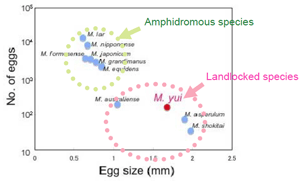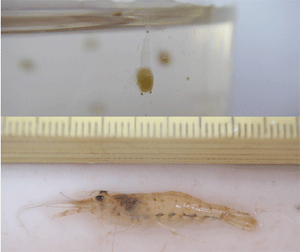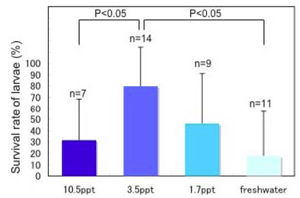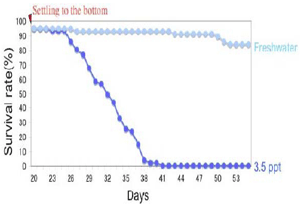Seed production technique of indigenous prawn Macrobrachium yui in Laos on the basis of primary life-history traits
Description
An indigenous prawn, Macrobrachium yui, inhabits the tributaries of the Mekong River in Northern Laos, and is a major source of cash income for farmers living in the river basin. In the research, we developed a new seed production technique for the prawn M. yui. This species has the same free swimming zoeal larval stage as other amphidromous species and live in the cave streams throughout their larval stage. In our experiment, the floating larvae developed and started to settle on the aquarium bottom at a high survival rate under rearing water condition of 3.5ppt artificial seawater. After settling on the aquarium bottom, the larvae needed freshwater as culture water in order to maintain a high survival rate. This indigenous prawn constitutes a major source of cash income for farmers living in the river basin because of its being traded at a high market price. Recently however, a decline in prawn catch has decreased the cash income of the farmers. The development of a better aquaculture technique is expected to be one of the efficient stock conservation measures for this prawn. However, the biological and ecological characteristics of the prawn have only been scarcely revealed, not to mention that there has been little success in the development of an improved seed production technology. The observed migratory behavior of the adult prawn which migrates from the main river to the cave streams predicted the existence of specific characteristics at the larval stage, and has become a clue to the development of an improved seed production technique for this prawn. We performed the experiments on seed production of the prawn while trying to gain understanding of its life-history traits under artificial culture or rearing and natural conditions.
Although the males and females of the prawn M. yui were reared in the tank separately, the females were able to brood fertilized eggs, implying that the females had already mated with males. Therefore, we mainly brought females to our laboratory for the experiments on seed production. Although females brood eggs all year round under artificial culture condition, the percentage of oviferous females becomes highest in June-July and November-December. The clutch size and egg size of the prawn M. yui fall into the category of those of land-locked species (Fig. 1). However, the morphology of the larvae approaches that of the adult after metamorphosis through the free swimming larval stage (Fig. 2). This developmental pattern is the same as that of the amphidromous species. The water of the cave stream where the prawn lives in during its free swimming larval stage indicates high electric conductivity and contains slight salinity. Amphidromous prawns which have the same short zoeal stage as the prawn M. yui can successfully pass through its larval stage at 10ppt salinity concentration. On the basis of these observations, we carried out the experiments on culturing the larvae of the prawn M. yui using artificial saline water of four concentrations such as 10.5, 3.5, 1.7, and 0 ppt. Based on the results, when 3.5ppt artificial saline water was utilized as the culture water, the survival rate of the larvae was steadily high until they settled to the tank bottom (Fig. 3). When we continued using 3.5ppt artificial seawater as rearing water after the larvae of the prawn had already settled to the tank bottom, their survival rate decreased. However, if we changed the rearing water from 3.5ppt artificial seawater into freshwater after the larvae had settled down to the bottom, the larvae grew into juvenile prawns at a higher percentage (Fig. 2 (lower picture), 4).
An intensive aquaculture of the prawn M. yui is not suitable for the farmers living in the river basin because of the backward infrastructure. On the possibility of a complete extensive aquaculture of the prawn, we should judge whether it is feasible or not on the basis of the characteristics of the aquatic ecosystem in the aquaculture site. The seed production technique of the prawn can be applied to the seed release activity of the prawn. Then, we should conduct the seed release in consideration of the impact to the natural population of the prawn. Moreover, we need to study the best growth stage for the seed release on the basis of its biological and ecological characteristics. The fertilized eggs of the prawn often drop down from the female abdomen during the brooding period. In order to get more larvae from one oviferous female, we need to develop a management technique for the parental prawn in the future.
Figure, table
-
Fig.1. Clutch size and egg diameter in Machrobrachium species.
(Green dotted circle: amphidoromous species; Pink dotted circle: land-locked species). -
Fig.2.
(Above) Free swimming larva just after the hatching of the land-locked prawn Machrobrachium yui; (Below) Juveniles of the prawn M.yui, 180 days after hatching. -
Fig.3.
Survival rate of the free swimming larvae (zoea) until they start to settle at the bottom under four salinity concentrations. -
Fig.4.
Transition of the survival rates of the larvae (post-larvae) after settling to the bottom in the case where the rearing water was changed to freshwater and in the case where 3.5 ppt artificial seawater was maintained as culture water.
- Affiliation
-
Japan International Research Center for Agricultural Sciences Fisheries Division
- Classification
-
Technical A
- Term of research
-
FY2008(FY2006~2010)
- Responsible researcher
-
ITO Sayaka ( Fisheries Division )
Lasasimma Oulaytham ( Living Aquatic Resources Research Center, Lao PDR )
Souliyamath Pany ( Na-Luang Fisheries Station, Luang-Prabang, Lao PDR )
- ほか
- Publication, etc.
-
Ito et al. (2008) Program and Abstracts. Japanese Society of Fisheries Science Meeting. p.228
Ito, S., Lasasimma, O., Souliyamath, P., Morioka, S., Khamsivilay, L. and Kitamura, S. (2008) Study on seed production in the indigenous prawn, Macrobrachium yui in Northern Laos. Abstract of the 5th World Fishery Conference.
- Japanese PDF




